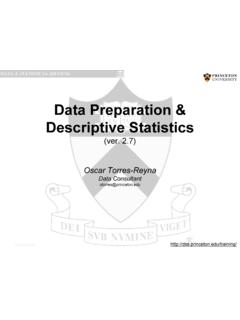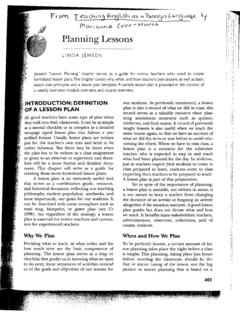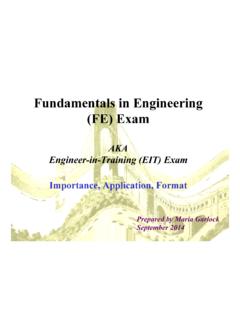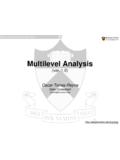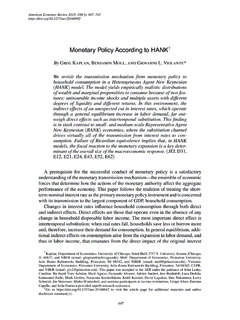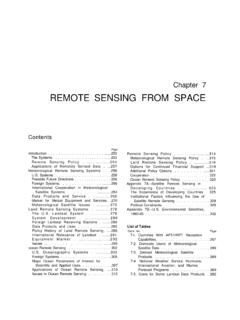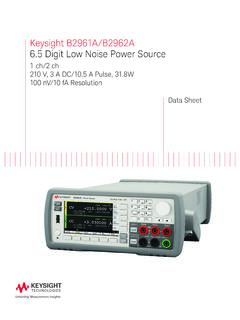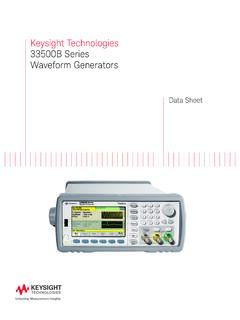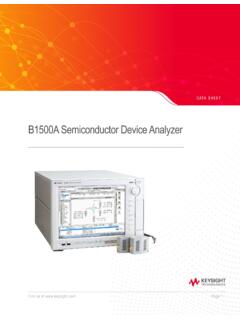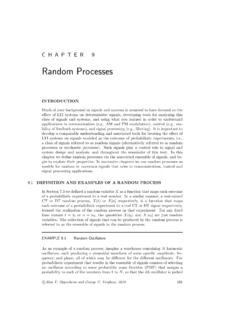Transcription of Lecture 3 ELE 301: Signals and Systems - Princeton University
1 Lecture 3 ELE 301: Signals and SystemsProf. Paul CuffSlides courtesy of John Pauly (Stanford) Princeton UniversityFall 2011-12 Cuff ( Lecture 3)ELE 301: Signals and SystemsFall 2011-121 / 55 Time Domain Analysis of Continuous Time SystemsToday s topicsImpulse responseExtended linearityResponse of a linear time-invariant (LTI) systemConvolutionZero-input and zero-state responses of a systemCuff ( Lecture 3)ELE 301: Signals and SystemsFall 2011-122 / 55 Impulse ResponseTheimpulse responseof a linear systemh (t) is the output of the systemat timetto an impulse at time . This can be written ash =H( )Care is required in interpreting this expression!Ht000t0 h(t,0)h(t, ) (t ) (t)ttCuff ( Lecture 3)ELE 301: Signals and SystemsFall 2011-123 / 55 Note:Be aware of potential confusion here:When you writeh (t) =H( (t))the variabletserves different roles on each side of the the left is a specific value for time, the time at which the outputis being the right is varying over all real numbers, it is not the sametason the output at time specific timeton the left in general depends onthe input at all timeston the right (the entire input waveform ).
2 Cuff ( Lecture 3)ELE 301: Signals and SystemsFall 2011-124 / 55 Assume the input impulse is at = 0,h=h0=H( 0).We want to know the impulse response at timet= 2. It doesn tmake any sense to sett= 2, and writeh(2) =H( (2)) No!First, (2) is something like zero, soH(0) would be zero. Second, thevalue ofh(2) depends on the entire input waveform , not just thevalue att= (t)tt00022h(2,0) (2)h(t,0)Cuff ( Lecture 3)ELE 301: Signals and SystemsFall 2011-125 / 55 Time-invarianceIfHis time invariant, delaying the input and output both by a time should produce the same responseh (t) =h(t ).In this case, we don t need to worry abouth because it is justhshifted h(t)h(t ) (t ) (t)ttCuff ( Lecture 3)ELE 301: Signals and SystemsFall 2011-126 / 55 Linearity and Extended LinearityLinearity:A systemSis linear if it satisfies bothHomogeneity:Ify=Sx, andais a constant thenay=S(ax).
3 Superposition:Ify1=Sx1andy2=Sx2, theny1+y2=S(x1+x2).Combined Homogeneity and Superposition:Ify1=Sx1andy2=Sx2, andaandbare constants,ay1+by2=S(ax1+bx2)Cuff ( Lecture 3)ELE 301: Signals and SystemsFall 2011-127 / 55 Extended LinearitySummation:Ifyn=Sxnfor alln, an integer from ( <n< ),andanare constants nanyn=S( nanxn)Summation and the system operator commute, and can (Simple Example): Ify=Sx, a( )y(t )d =S( a( )x(t )d )Integration and the system operator commute, and can ( Lecture 3)ELE 301: Signals and SystemsFall 2011-128 / 55 Output of an LTI SystemWe would like to determine an expression for the outputy(t) of an lineartime invariant system, given an inputx(t)xyHWe can write a signalx(t) as a sample of itselfx(t) = x( ) (t)d This means thatx(t) can be written as a weighted integral of ( Lecture 3)ELE 301.
4 Signals and SystemsFall 2011-129 / 55 Applying the systemHto the inputx(t),y(t) =H(x(t))=H( x( ) (t)d )If the system obeys extended linearity we can interchange the order of thesystem operator and the integrationy(t) = x( )H( (t))d .The impulse response ish (t) =H( (t)).Cuff ( Lecture 3)ELE 301: Signals and SystemsFall 2011-1210 / 55 Substituting for the impulse response givesy(t) = x( )h (t)d .This is asuperposition integral. The values ofx( )h(t, )d aresuperimposed (added up) for each input time .IfHis time invariant, this written more simply asy(t) = x( )h (t)d .This is in the form of aconvolution integral, which will be the subject ofthe next ( Lecture 3)ELE 301: Signals and SystemsFall 2011-1211 / 55 Graphically, this can be represented as:t0th(t)0t0t0 (t)t0t0t0t0x(t)y(t)(x( )d ) (t )(x( )d )h(t ) (t ) x(t)x(t)=Z x( ) (t )d y(t)=Z x( )h(t )d InputOutputh(t )Cuff ( Lecture 3)ELE 301: Signals and SystemsFall 2011-1212 / 55 System EquationTheSystem Equationrelates the outputs of a system to its from last time: the system described by the block diagram++-Zaxyhas a system equationy +ay= addition, the initial conditions must be given to uniquely specify ( Lecture 3)ELE 301: Signals and SystemsFall 2011-1213 / 55 Solutions for the System EquationSolving the system equation tells us the output for a given output consists of two components.
5 Thezero-inputresponse, which is what the system does with no inputat all. This is due to initial conditions, such as energy stored incapacitors and (t)x(t)=0 Cuff ( Lecture 3)ELE 301: Signals and SystemsFall 2011-1214 / 55 Thezero-stateresponse, which is the output of the system with allinitial conditions (t)x(t)tIfHis a linear system, its zero-input response is zero. Homogeneitystates ify=F(ax), theny=aF(x). Ifa= 0 then a zero inputrequires a zero (t)=0y(t)=0tCuff ( Lecture 3)ELE 301: Signals and SystemsFall 2011-1215 / 55 Example:Solve for the voltage across the capacitory(t) for an arbitraryinput voltagex(t), given an initial valuey(0) =Y0.+ RCy(t)+ x(t)i(t)Cuff ( Lecture 3)ELE 301: Signals and SystemsFall 2011-1216 / 55 From Kirchhoff s voltage lawx(t) =Ri(t) +y(t)Usingi(t) =Cy (t)RCy (t) +y(t) =x(t).
6 This is a first order LCCODE, which is linear with zero initial we solve for the homogeneous solution by setting the right side (theinput) to zeroRCy (t) +y(t) = solution to this isy(t) =Ae t/RCwhich can be verified by direct ( Lecture 3)ELE 301: Signals and SystemsFall 2011-1217 / 55To solve for the total response, we let the undetermined coefficient be afunction of timey(t) =A(t)e this into the differential equationRC[A (t)e t/RC 1 RCA(t)e t/RC]+A(t)e t/RC=x(t)SimplifyingA (t) =x(t)[1 RCet/RC]which can be integrated fromt= 0 to getA(t) = t0x( )[1 RCe /RC]d +A(0)Cuff ( Lecture 3)ELE 301: Signals and SystemsFall 2011-1218 / 55 Theny(t) =A(t)e t/RC=e t/RC t0x( )[1 RCe /RC]d +A(0)e t/RC= t0x( )[1 RCe (t )/RC]d +A(0)e t/RCAtt= 0,y(0) =Y0, so this givesA(0) =Y0y(t) = t0x( )[1 RCe (t )/RC]d zero state response+Y0e t/RC zero input ( Lecture 3)ELE 301: Signals and SystemsFall 2011-1219 / 55RC Circuit exampleThe impulse response of the RC circuit example ish(t) =1 RCe t/RCThe response of this system to an inputx(t) is theny(t) = t0x( )h (t)d = t0x( )[1 RCe (t )/RC]d which is the zero state solution we found ( Lecture 3)ELE 301: Signals and SystemsFall 2011-1220 / 55 Example.
7 High energy photon detectors can be modeled as having a simpleexponential decay impulse the PMT socket containing the dynode resistor chainbias network, is 3 cm long, 3 cm wide, and cm METHODS DETECTOR CHARACTERIZATIONA. Flood source histogramA detector module was uniformly irradiated with a68 Gepoint source! "Ci#. The Signals from the PS-PMT weretreated and digitized as described above in Sec. II D. Thelower energy threshold was set to approximately$100 keVwith the aid of the threshold on the constant fraction dis-criminator and no upper energy threshold was Energy spectraBoundaries were drawn on the 2D position map to definea look-up table!LUT#which relates position in the 2D his-togram to the appropriate element in the LSO array. The rawlist mode data were then resorted and a histogram of totalpulse amplitudes!
8 Sum of the four position outputs#gener-ated for each crystal in the array. These energy spectra wereanalyzed to determine the FWHM and the location of the511 keV photopeak of each crystal. These two parametersmeasure the energy resolution and light collection efficiency, Timing resolutionTwo detectors were aligned facing each other, 15 cmapart, and connected in coincidence. A22Na point source! "Ci#encapsulated in a mm diameter, 3 mm thickclear plastic disc with the activity in the central 1 mm wasplaced in the center of the two detectors. For each detectedcoincidence event, the sum of the four position Signals foreach detector was sent to a constant fraction discriminatorwhich generated timing pulses. The lower energy thresholdon the CFD was set to approximately 100 keV. These twotiming pulses!one for each module#were in turn fed into acalibrated time-to-amplitude converter!
9 TAC#module. Theoutput from the TAC was then digitized to produce the tim-ing Coincidence point spread functionFlood source histograms of both detectors were obtainedas described in Sec. III A from which the position LUTswere defined. The detectors were then configured in coinci-dence, 15 cm apart, and list-mode data was acquired by step-ping a 1 mmdiameter22Na point source!same as used inSec. III C#between the detectors in mm steps. Thepoint source was scanned across the fifth row of the each opposing crystal pair, the counts were recorded as afunction of the point source position. A lower energy win-dow of$100 keV was applied. The FWHM of the resultingdistribution for each crystal pair was determined to give theintrinsic spatial resolution of the Detector efficiencyA measure of the absolute detector efficiency was ob-tained.
10 A18F point source with known activity!68"Ci#wasplaced 15 cm away from the face of the detector module. Theactual gamma-ray flux impinging on the detector face wascalculated from the solid angle subtended by the detectormodule at the source. The constant fraction discriminatorwas set to eliminate electronic noise ($100 keV#and the fullenergy spectrum was obtained for each crystal over a fixedtime. A background measurement without the18F pointsource was also obtained to subtract the LSO backgroundfrom the measurement. A lower energy window of 350 keVwas applied to all of the crystals and the number of countsfalling under the photopeak was calculated. The number ofcounts detected was then divided by the total number ofgamma rays impinging on the detector module to obtain thedetector RESULTS DETECTOR CHARACTERIZATIONA.)
